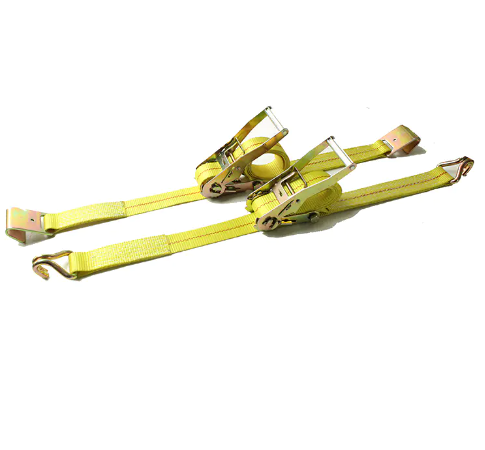Cat:1Inch Metal Ratchet Buckle
A 1-inch 25mm metal ratchet buckle is a type of buckle that is 1 inch in 25mm width and made of metal. It is commonly used for securing and tie down s...
See Details
1. Selection and inspection of tie down straps
Specification matching:
Choose the appropriate width (such as 2.5cm to 10cm) and material (polypropylene, polyester or nylon) according to the weight and size of the goods. Heavy goods need to use tie down straps with high breaking strength (such as 800kg~10000kg). When using tie down straps, check whether the tie down straps have signs of wear, breakage or aging. The label must clearly indicate the load-bearing capacity. Damaged products are prohibited from use.
Environmental adaptability:
The suitable temperature range for the use of tie down straps is usually -40℃~100℃ (the upper limit of polypropylene material is 80℃). Avoid using in high temperature or extremely cold environments. Long-term exposure to ultraviolet rays will reduce the strength. Avoid using in strong radiation or corrosive environments (such as near acids and molten metals).
2. Correct use method
Fixing and tightening skills——
Hooking and fixing: fix the hook end of the belt firmly to the anchor point of the vehicle or pallet to avoid sliding; the webbing needs to pass through the ratchet shaft and rotate at least 2.25 turns (9/4 turns) to ensure locking.
Uniform force: use cross-tying or ring-tying to disperse the pressure to avoid single-point force causing breakage. For example, cylindrical goods need to be reinforced at both ends and in the middle.
Proper tightening: apply force gradually when using the ratchet tensioner to avoid damaging the goods by overtightening or shifting due to over-loosening.
Protective measures——
Use protective sleeves or anti-skid pads to isolate sharp edges and prevent the webbing from being cut.
It is forbidden to knot or twist the strapping to avoid reducing the strength.
3. Safety taboos and maintenance
It is strictly forbidden to overload or modify the strapping, and it cannot be used for lifting goods (fixed use only).
Avoid placing heavy objects or stepping on the strapping to prevent accidental injuries.
Maintenance and storage——
The product is cleaned and stored dry after use, away from fire and chemicals. It is recommended that polyester/nylon materials be replaced every 2 years.
Regularly check whether metal parts such as ratchets and hooks are deformed or rusted.
4. Precautions for special scenarios
Container transportation-
Heavy goods such as wooden boxes need to use square wooden strips to fix the center of gravity horizontally, and high-center-of-gravity goods need additional top support. Anti-slip mats or air bags can prevent goods from sliding, and iron hooks and latches must be connected to the fixed points on the inner wall of the container.
Dangerous goods-
Use anti-static or anti-corrosion materials and operate by certified personnel.
5. Inspection after bundling
Before transportation, confirm that all fixed points are firm and not loose; check regularly during the journey (especially on bumpy roads) and adjust in time. The above measures can maximize transportation safety. The specific operation needs to be combined with the characteristics of the goods and industry specifications, and consult professionals when necessary.